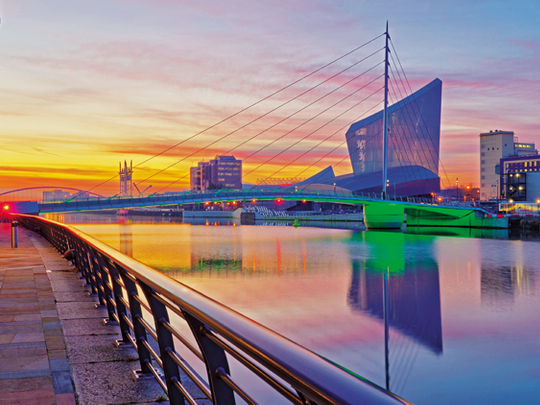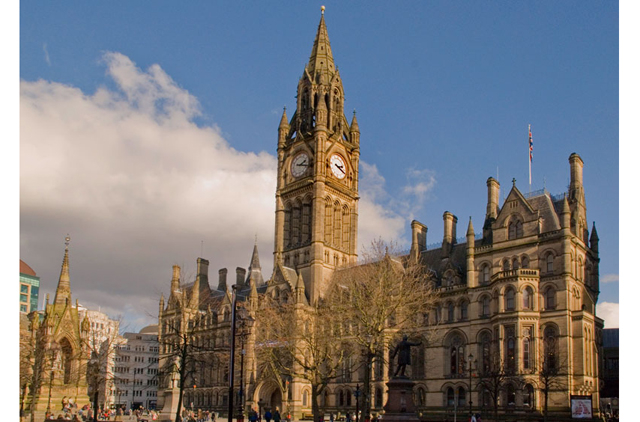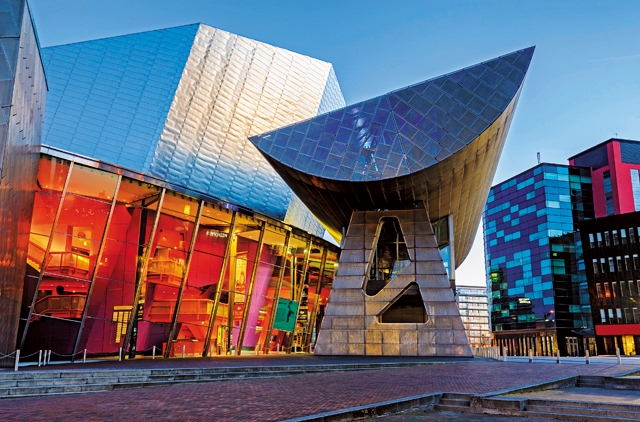
What is Manchester’s export to the world? No, it’s not former Manchester United and England star, David Beckham. The correct answer is: cotton. Surprised? Well, Manchester is full of surprises and firsts. It was the site of the first passenger railway station and the first stored-program computer; it’s the birthplace of the Industrial Revolution and it’s where England’s first professional football league was set up.
In addition to the rich heritage, there are spectacular sights in the city – particularly around Salford Quays, which is home to Old Trafford, The Imperial War Museum North and The Lowry Arts and Entertainment Centre. The latter houses a theatre and galleries showcasing the works of famous English artist L S Lowry, who made a lasting impression on the world art scene with his distinctive painting style, featuring industrial landscapes containing lots of small figures or ‘matchstick men’.
Manchester is also famous for its entertainment scene – it boasts a range of music venues, including one of Europe’s largest indoor arenas, and world-famous bands, from rockers Oasis to Seventies pop stars, The Bee Gees, and Eighties icons, The Smiths, have roots there.
Walk this way
The best way to experience the city is on foot so, a few hours after landing in Manchester, I took a walking tour, which started at the grand Midland Hotel. Built in 1903, the hotel, which is shaped like a figure of eight, is located in the heart of the city and has a luxurious heritage – Charles Rolls and Henry Royce are said to have met there in 1904, starting the partnership that saw the birth of the elite car brand.
A turn around the block took me to the Manchester Central Convention Centre, which was originally a train station, but is now a public hall that hosts political party conferences. A few blocks down Peter Street is the Radisson Hotel. The building has a rich history, as it was originally a Free Trade Hall that has served as an important centre for politics and music in the past.
Standing on St Peter’s Fields, the site of the Peterloo Massacre, it was a hotbed for the women’s suffrage movement, and it was also the venue where acoustic legend Bob Dylan received heavy criticism for performing with an electric band in 1966. If you’re more of a classical music fan, head to Bridgewater Hall, where The Hallé Orchestra, The Manchester Camerata, The BBC Philharmonic and numerous pop and rock shows play throughout the year.
It’s an example of architectural genius – the structure floats free of the ground on around 300 giant springs, ensuring that the indoor acoustics are protected from all outside noise and vibration. So as trams and buses trundle along the busy road outside, the show goes on undisturbed inside. Next was Manchester Town Hall. Completed in 1887, the imposing stone building is said to be one of the best examples of Victorian Gothic architecture in the country.
It has been used for filming TV shows and Victorian period drama productions, as well as The Iron Lady, a film about former British Prime Minister Margaret Thatcher. After weaving through a maze of alleys and streets, we emerged at the Royal Exchange Theatre, a former 20th-century cotton trading hall. Although it has now been converted into a shopping centre and theatre that holds more than 300 people over three levels, the prices of cotton from the last day of trading in 1968 are still on display.
Known as the Cottonopolis during its heyday, this building serves as a reminder of times gone by. Having worked up an appetite, upon my return to the hotel, I headed to The French Restaurant for dinner. This cosy nook is where David and Victoria Beckham had their first date in 1997, while he was playing for Manchester United and she was on tour with the Spice Girls. I ploughed into the gourmet continental cuisine, while taking in the tastefully decorated surroundings.
Reflecting on my leisurely stroll through the city, I felt like I was flicking through the pages of an architecture magazine. Although Manchester has been bombed twice – during the Second World War and in 1996 by the IRA (Irish Republican Army) – it retains much of its original charm. Gothic cathedrals with pointed windows stand side-by-side with stunning Georgian and Victorian structures.
But Manchester is not just a historical gem. In its buzzing city centre, the old architecture blends with the new to form a delightful cocktail of cosmopolitan city living. The city boasts modern shopping centres with all the leading brands, hip restaurants and pubs and has a vibrant nightlife scene.
A city to explore
This city invites exploration along its cobbled streets and intricate alleys, so each day I walked to a different place. On my second day, I visited the National Football Museum, explored the People’s Museum, then walked to Exchange Square. The square, which was rebuilt after the IRA bombing, is a shopping hub. It is surrounded by the Arndale Centre, The Triangle shopping centre and, best of all, Selfridges – my favourite for retail therapy.
Since we don’t have a Selfridges store in Dubai, I made sure to check it out thoroughly. I began at the top and worked my way down the floors. This was great, but, as someone who lives in Dubai and isn’t used to walking, my legs began to hurt. So I decided to indulge my love of pampering and put my feet up with a relaxing facial at the Fake Bake Hair and Beauty salon, followed by a manicure at the beauty counters.
Perfectly preened, but burdened with bags full of the fruits of my shopping trip, I felt too tired to walk back to the hotel. I was going to hail a cab, but then I realised that my expensive retail therapy had left me with no spare cash. Lucky for me then, that there are free buses around the city. The buses are owned by the council and sponsored by local businesses. I hopped on and, before I knew it, I was back at St Peter’s Square by my hotel.
I received appreciative looks as I waltzed into the lobby, but I’m not sure if they were because of my glowing face or the yellow Selfridges bags I was holding with my neatly manicured fingers. In the evening, I headed to the Manchester Art Gallery for the official opening of the Manchester Weekender – a festival featuring more than 80 events to highlight the city’s art and culture offerings.
With a backdrop of the gallery’s new exhibition, Manchester-based jazz singer-songwriter Kirsty Almeida put on a great show, combining art and music. Other highlights included Pre-Raphaelite pieces and a selection of art, from the 17th century, right up to the present day. My evening ended with dinner at Pacific, European and pan-Asian fusion restaurant, Australasia.
I was blown away by the startling entrance – a pyramid-shaped block of glass rising from the pavement. Once inside, an escalator took me down to an underground restaurant located below Spinningfields Mall. The eatery has a wide range of interesting flavours and foodie delights.
I went for salmon marinated in soy treacle for starter, followed by corn-fed chicken breast filled with mushrooms and truffle with rough-cut chips and roasted aubergine with miso mustard and ended with baked banana boat and popcorn ice cream – perfect comfort food for a rainy night. Plus, if you dine here on a weekend, the restaurant transforms into a buzzing late lounge after 11pm.
East meets West
On the third day, I’d finally built a bit of strength in my legs and the walking was getting easier, so I was eager to continue on the cultural trail. First up was the Manchester Museum, located at the University of Manchester. Here I came face-to-face with dinosaur skeletons, preserved mummies and a fascinating zoological collection that included plenty of live creepy-crawlies.
A 15-minute walk from the university took us to Wilmslow Road in Rusholme, referred to by Mancunians as ‘The Curry Mile’. On this stretch, Western and Eastern cultures meet – and the results are fun and delicious. The neighbourhood is filled with interesting shops and cafés – from shisha bars and shawarma joints, to traditional English pubs and stores selling Indian clothing.
Further down the road, is the Gallery of Costume, Platt Hall. Set on an expansive, green park, it has one of the largest collections of clothing and fashion accessories in the UK. As impressed as I was by the Gallery of Costume, all this sightseeing was making me peckish, so I made my way to a Syrian restaurant for a snack. Watching diners enjoy shisha in cold and rainy Manchester felt a little weird.
In the evening, I visited The Museum of Science and Industry in Castlefield for a screening of 1940s film, Brief Encounter, a movie that was recently voted the most romantic film of all time by The Guardian. Watching the film, which is largely featured around trains, in the world’s first railway warehouse made the experience all the more pleasurable. On my last day, I took a tram from the city centre to Salford Quays. This waterfront destination has something for everyone.
If you’re into water sports, head to Salford Water Sports Centre, which offers sailing, windsurfing, kayaking and open canoeing. Or if, like me, you don’t want to get wet, you can still hop on the Joke Boat and enjoy a city cruise. On board, comedian Sam Avery, who was in town for the Weekender, gave a comic’s view of the buildings, including local facts – and fiction – and had the crowd in fits of laughter.
Then it was time to check out the Manchester United Museum and go on a stadium tour of Old Trafford. This legendary stadium will have football fans in bliss. If you still have time on your hands, you can explore the Lancashire County Cricket Club and the Imperial War Museum North, which features a host of historical artefacts from Britain’s military past. During my final hours in Manchester, I took the tram back to the city centre and got off at the bustling Picadilly Gardens.
I browsed the stalls in the open market and watched the trams go by. Feeling hungry, I went over to a food stall with a placard that read, ‘Ostrich-meat burger’. Not the first thing you might think of being in Manchester, but I love to sample exotic dishes, so I gave it a go. The meat was succulent, grilled to perfection and it reminded me of Wagyu steak.
Four days to explore such a large and intriguing place was far too short. For those in search of heritage, culture, and some impressive UK history, look beyond London and give the North of England a try. With everything you could want from a world-class city, it’s time to put the bright northern lights of Manchester on the map.















